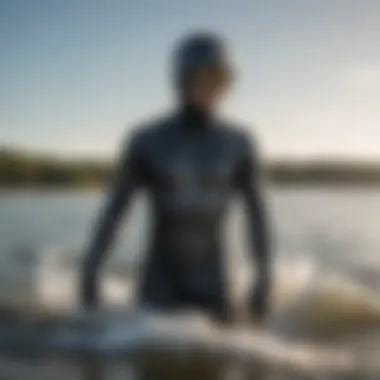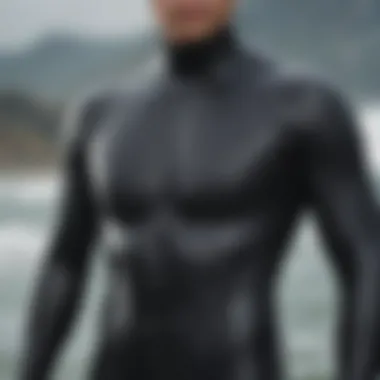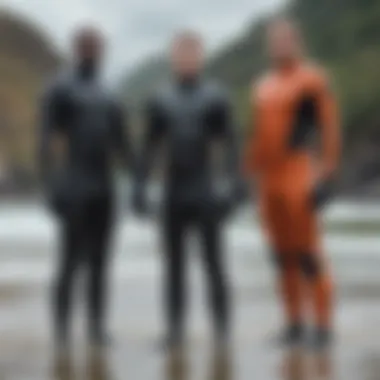Top Rated Wetsuits for Kiteboarding Enthusiasts


Intro
Kiteboarding is more than just a sport; it's a lifestyle embraced by many who crave the exhilaration that comes with riding the waves. As much as the thrill of the wind on your face and the rush of gliding over water is exhilarating, choosing the right wetsuit can make all the difference in your water sports experience. A wetsuit does not merely provide warmth; it is also a critical aspect of your comfort and performance when kiteboarding.
With countless options on the market, each claiming to offer the best features, it can feel like searching for a needle in a haystack. There’s a myriad of factors to consider from the materials used to the fit and thickness of the wetsuit. This guide aims to sift through the noise, presenting key insights into what makes a wetsuit rated highly by enthusiasts and experts alike.
The aim here is not just to review wetusits, but to know why certain features enhance your kiteboarding experience, particularly in varying water conditions. By diving into the specifics—like insulation types and design specifications—readers will come away with a deeper understanding, aiding them in making informed purchase decisions.
Techniques
Beginner Kiteboarding Techniques
If you're new to kiteboarding, it's imperative that you arm yourself with foundational techniques that will set you up for success on the water. First and foremost, mastering the basic stance while riding is key; keep your knees slightly bent, and your body fluid and responsive to the forces around you.
Moreover, learning to control the kite with precision is crucial. This involves both flying the kite efficiently in light winds and adjusting technique as wind conditions change. Practicing body dragging can help build confidence, allowing you to learn how to control both the kite and your board without the added complexities of jumping or tricks.
Advanced Freestyle Maneuvers
Once you've got the basics down, it’s time to confront the fun part: adding flair to your kiteboarding with advanced freestyle maneuvers. These tricks hinge on a combination of timing, skill, and a solid understanding of your equipment. Skills like the kite loop, which involves a rapid circular motion of the kite, or a handle pass, where the rider passes the handle of the bar behind their back mid-air, require both finesse and confidence.
"A proper wetsuit can keep you comfortable and safe in cooler waters, amplifying your ability to focus on perfecting these tricks."
Your wetsuit should offer freedom of movement without restrictive pressure in key areas. This means considering not only the thickness and fit but also the flexibility of materials used.
Gear Reviews
Latest Kiteboarding Equipment
When it comes to kiteboarding, the right equipment can enhance the experience significantly. This section will cover some of the top-rated kites, boards, and safety gear that pair effectively with your wetsuit. The combination of the right kite and board ensures that every session is enjoyable.
Essential Accessories for Kiteboarders
Beyond the basics of wetsuits and boards, there are accessories that can elevate your kiteboarding outings. Items like impact vests, harnesses, and booties can improve comfort and safety. A good harness, for instance, should distribute pressure evenly across your body while enabling you to steer the kite effectively.
Ultimately, kiteboarding is a combination of skill, equipment, and understanding local conditions. As you navigate this thrilling sport, remember that the right wetsuit is not merely an investment in comfort but a commitment to enhancing your overall performance.
Understanding Wetsuits
Wetsuits serve as a crucial element in the repertoire of any water sports enthusiast, particularly for kiteboarders who face varying water temperatures and conditions. Understanding the nuances of wetsuits is essential for making informed choices that enhance comfort, performance, and safety in the water. A suitable wetsuit acts like a second skin, allowing freedom of movement while providing necessary insulation. It’s not just about style; it’s about surviving the elements.
The Role of Wetsuits in Water Sports
Wetsuits are primarily designed to create a thin barrier of water between the suit and the body, which is then warmed by the body heat. This is particularly important for kiteboarding, where prolonged exposure to cooler water can lead to hypothermia. Appropiate wetsuits can prevent this while optimizing buoyancy and aiding in performance on the board. Kiteboarders will find that wearing a wetsuit makes it easier to ride the waves—granting them a competitive edge while ensuring their bodies stay warm in frigid waters.
Whether you are a seasoned rider or just starting, knowing how a wetsuit influences your performance is key. The right suit can enhance your agility, while an ill-fitting one can hinder movement—impacting overall enjoyment and safety on the water. As such, understanding different wetsuit types and their specific functions becomes paramount for anyone diving into this vibrant sport.
Key Components of Wetsuit Construction
The construction of a wetsuit is a delicate balance of materials, design, and functionality. Each component contributes to the efficiency and effectiveness of the suit when in use.
Neoprene and Its Variants
Neoprene, the primary material used in wetsuits, is renowned for its excellent insulating properties. Its flexibility allows for improved range of motion, which is vital when maneuvering on a board. There are several variants of neoprene available—like closed-cell and open-cell types.
Closed-cell neoprene is filled with tiny bubbles that trap air, providing insulative benefits. On the flip side, open-cell neoprene absorbs water but offers more flexibility, making it a popular choice for warmer water applications. Each type comes with its own set of advantages and disadvantages; closed-cell neoprene excels in insulation but might feel bulkier, whereas open-cell is lightweight but less protective in colder waters.
Stitching Techniques
The method of stitching can influence the durability and warmth of a wetsuit significantly. Flatlock stitching, for instance, is common due to its flat profile and comfort, but it might let in a bit of water. A more robust technique, the blind stitch, involves overlapping the neoprene layers and preventing water ingress, making it highly favorable for cold-weather use. Understanding these techniques helps riders select a suit that not only fits well but withstands wear and tear.
Zipper Designs
Zipper options can sometimes feel like an afterthought, but they can greatly affect your experience in and out of the water. Back zippers are traditional and easy to use, but front zippers or even no zippers at all (like a zipless design) can offer more flexibility and reduce water entry. The feature that makes them beneficial is their sealing capabilities when designed properly. However, a poorly designed zipper can result in water leaks, which is the opposite of what any kiteboarder wants.


"The right wetsuit is more than just gear; it’s confidence and protection in aquatic pursuits."
In summary, understanding the key components and their impacts on performance can lead to better purchasing decisions for kiteboarders, ultimately enhancing their water sports adventures.
Criteria for Evaluating Wetsuits
When selecting a wetsuit, it is critical to pay attention to specific criteria that can significantly influence your comfort and performance in the water. Understanding these evaluating factors not only saves you from costly mistakes but also ensures that you get the wet suit that fits your needs like a glove. So, let’s dive into what to look for.
Fit and Comfort Considerations
A wetsuit should feel snug but not restrictive. The fit is a fundamental aspect of performance and warmth; if it's too loose, water may flow in, defeating the purpose of insulation. Keep in mind that body shape varies widely, and wetsuit manufacturers often cater to different physiques. Look for suits that offer a range of sizes or custom options.
Comfort also relates to the materials used. Many wetsuits employ an internal thermal lining for extra coziness. Feeling comfortable in your suit can mean the difference between a memorable kiteboarding session and wishing you'd stayed on dry land. Some suits come with features like ankle seals and wrist cuffs that help exclude water, enhancing comfort and warmth further.
Thermal Insulation Features
Thermal insulation is crucial, particularly if you're spending long hours in colder waters. The key here is to understand the role of thickness ratings and seam technology in keeping you warm.
Thickness Ratings
Thickness ratings indicate how thick the neoprene is in millimeters and generally vary from 2mm for warm waters to 6mm for icy conditions. A thicker wetsuit provides more warmth but can compromise flexibility.
The key characteristic of thickness ratings makes them a popular choice among kiteboarders looking to balance warmth with movement.
- Thin suits (2-3mm) are ideal for warm climates, allowing for enhanced maneuverability.
- Mid-range suits (4-5mm) offer versatility for cooler temperatures without sacrificing too much agility.
- Thick suits (6mm+) are reserved for arctic waters, prioritizing heat retention.
The unique feature of all these thicknesses is their ability to cater to different water conditions, ensuring you stay warm regardless of where you’re riding. However, you should consider that thicker suits are less flexible, which might hinder specific moves in kiteboarding.
Seam Technology
The seam technology plays another critical role in a wetsuit's warmth and durability. There are several seam types: flatlock, glued and blind-stitched seams, and sealed seams. Each has its strengths and weaknesses.
Glued and blind-stitched seams are renowned for being watertight, making them a favored option for cold-water sports.
- Flatlock seams are often used in warmer suits as they are durable and simple, although they don’t completely block water.
- Sealed seams are typically found in higher-end wetsuits, providing improved insulation and comfort.
Investing in a suit with high-quality seams can lead to a much more satisfying experience on the water. If you’re serious about kiteboarding, this is one consideration that could save you from feeling the chill.
Flexibility and Mobility Attributes
When you're out there riding the waves, nothing is more frustrating than being restricted by your gear. A good wetsuit should allow you to twist, turn, and leap with ease.
Flexibility is achieved through a combination of materials and design. The cutting edge technology in wetsuit manufacturing today focuses on ergonomic designs and high-stretch neoprene. Some suits incorporate innovative panel designs to enhance movement in the upper body, allowing for more freedom during kiteboarding maneuvers.
Ensuring your wetsuit has the right mobility attributes can lead to better performance and greater enjoyment while kiteboarding. Look for suits that brag about their flexibility but remember, you should try them on to feel the difference for yourself.
Exploring Top Rated Wetsuit Brands
When navigating the world of water sports, especially for kiteboarding, the brand of wetsuit you choose plays a critical role. Selecting a top-rated wetsuit brand means aligning your personal needs with a manufacturer’s reputation for quality, performance, and innovation. Each brand brings unique offerings to the table, which can significantly influence both comfort and overall experience on the water. Understanding the distinct characteristics of these brands helps you make an informed decision that fits your style and conditions.
Brand A Overview
Unique Selling Points
Brand A is known for its advanced thermal insulation technology. This brand particularly emphasizes its use of recycled materials, making it an environmentally-friendly option for the eco-conscious kiteboarder. Their sustainable approach doesn’t just provide warmth but also resonates with consumers looking to minimize their carbon footprint. Moreover, the durability of the materials used stands out, promising a long-lasting product that can withstand the rigors of repeated use in water sports.
The unique selling point here is that it targets two main concerns: performance in cold waters while being gentle on the environment. Customers often rave about its lightweight feel, making it a favorite choice for those looking for an agile fit.
Popular Models
Among the popular models is the AquaFlex Series. This wetsuit has gained traction for its superior flexibility and fit, which are essential for kiteboarding maneuvers. Users have noted how the seamless design allows freedom of movement without compromising warmth. The AquaFlex isn’t just about looking good; it's specifically engineered with performance in mind.
But a word of caution — while it feels comfy and performs well, it may not hold up as well in very sharp conditions compared to more robust models.
Brand B Overview
Unique Selling Points
Brand B excels with its revolutionary adjustable fit technology. This approach allows users to fine-tune the fit of their wetsuits. It’s a fantastic option for those who fret about sizing, as it can adapt to various body shapes and sizes, thus eliminating the age-old dilemma of finding the perfect wetsuit.


The adjustable feature isn’t just a gimmick; it provides increased comfort, reducing water ingress and enhancing thermal protection. This is particularly useful for kiteboarders who spend extended periods in the water. The focus here is clearly on fitting as many individuals as possible, making it a widely accepted choice among users.
Popular Models
One standout model is the AdjustoFit Pro, a wetsuit that seamlessly integrates this fitting technology with high-quality neoprene. Kiteboarders have praised it for providing both a snug fit and essential insulation against wind chill. The versatility of this wetsuit means it can be used in varied conditions, which is perfect for those who kiteboard in different waters. However, be aware that while the advanced fit is a boon, some may find the mechanism complicated or cumbersome after extended use.
Brand Overview
Unique Selling Points
Brand C shines due to its innovation in buoyancy-assisted design. Aimed at beginner and intermediate kiteboarders, these wetsuits provide additional buoyancy, which can be quite beneficial when learning how to balance on a board. The ingenious design promotes ease of use while still catering to performance.
This feature adds more value, especially to those who may not have the same level of confidence on the water yet. Naturally, this brand is regarded highly for making the sport more accessible to newbies.
Popular Models
The Beginner's Edge Suit is one of Brand C's flagship products. This suit is crafted to boost confidence while facilitating an enhanced learning curve. Customers highlight how it helps them stay afloat better, allowing for more time to focus on mastering techniques instead of struggling with balance. Despite its advantages, the buoyancy aspect might not appeal to advanced users who prefer a more streamlined suit, which is something to consider if you’re well beyond the beginner phase.
Performance Analysis in Different Conditions
When it comes to wetsuits, understanding how they perform in various conditions is essential. Kiteboarding enthusiasts need to consider performance analysis as a crucial factor in their decision-making process. The right wetsuit can make a world of difference, allowing a rider to stay comfortable and agile regardless of the environment.
Specific Elements to Consider
Performance analysis takes into account factors such as thermal insulation, flexibility, and water resistance. Each of these aspects can significantly impact how a wetsuit performs in varying conditions, which in turn affects the overall experience during kiteboarding sessions. Whether you’re braving the icy waters or enjoying warmer climates, getting well-acquainted with your wetsuit's performance can ensure you have a safe and enjoyable ride.
Benefits of Performance Analysis
Evaluating a wetsuit’s performance in different conditions helps kiteboarders make informed choices tailored to their specific needs. This knowledge can help you stay warm in cold waters or avoid overheating in warmer conditions. Ultimately, the benefits of this analysis range from enhancing comfort to boosting mobility, leading to an overall improved kiteboarding experience.
Cold Water Performance
Cold water poses unique challenges to any kiteboarder. Here, the wetsuit’s thermal insulation becomes paramount. Wetsuits designed for cold water often feature thicker neoprene materials that trap heat, preventing the body from succumbing to the chilling environment.
Key characteristics of effective cold water wetsuits include:
- Thickness: A wetsuit of 5mm or more is generally recommended for cold conditions.
- Sealing Mechanisms: Seam technology plays an essential role in minimizing water entry. Suited seams, like blind-stitching, ensure that very little water leaks in.
- Inner Linings: Thermal linings can also enhance warmth by reflecting body heat back to the skin.
"Choosing the right wetsuit for cold water is not just about warmth; it's about ensuring you remain nimble and responsive on the board."
Ultimately, it’s worth noting that wearing an ill-fitting wetsuit can lead to a range of issues, from restricted movement to hypothermia. Always pay attention to the wetsuit’s fit, ensuring that it hugs your body without restricting motion.
Warm Water Applications
Contrastingly, warm waters require a different approach. Riders must balance staying protected from the sun and avoiding overheating. For warm water conditions, it's advisable to choose thinner wetsuits or even shorties.
Considerations for choosing a warm water wetsuit include:
- Thickness: Typically, 2mm to 3mm is sufficient for warmer water.
- Breathability: Well-designed wetsuits offer breathable materials that allow sweat and moisture to escape, keeping you cool.
- Minimal Coverage: Wetsuits with short sleeves or legs can help keep temperatures down.
In warm climates, the goal is often to keep the body cool while still offering some protection from UV rays. Therefore, many kiteboarders opt for wetsuits with features like UPF protection.
Variable Weather Adaptability
Lastly, adaptability to variable weather conditions is non-negotiable for kiteboarders. Weather can change quickly, and a wetsuit that can handle such fluctuations is a valuable asset. Look for features that cater to versatility:
- Convertible Designs: Some wetsuits have removable sleeves or legs, offering the flexibility to adapt to changing conditions.
- Quick-Drying Materials: If you find yourself in both wet and dry situations, quick-drying fabric can be a significant advantage.
- Layering Options: Keeping the ability to layer your wetsuit allows for adjustments to be made on the fly.
In regions where climates can be unpredictable, opt for wetsuits that provide excellent breathability combined with robust insulation. This way, you can hit the water in confidence, knowing your gear is prepared for whatever the weather throws at you.
Maintaining Your Wetsuit
Maintaining your wetsuit is not just about keeping it clean; it’s about ensuring its longevity and performance. For kiteboarders, a wetsuit represents protection against cold, chafing, and potential injuries from the water elements. A well-cared-for wetsuit can mean the difference between an enjoyable day on the waves or an uncomfortable experience. You wouldn’t drive a car without getting the oil changed, right? Similarly, investing time in wetsuit maintenance pays dividends in performance and comfort.
Best Practices for Care
Caring for your wetsuit should be straightforward, provided you incorporate a few best practices into your routine:
- Rinse After Use: Always give your wetsuit a good rinse in fresh water after coming out of the ocean or lake. Salt and chlorination can eat away at the material if left unchecked.
- Dry It Properly: Hang your wetsuit inside-out on a wide hanger to air dry in a shaded area. Avoid direct sunlight since UV rays can degrade neoprene.
- Storage Considerations: When storing for the off-season, lay your wetsuit flat or hang it in a cool, dry space. Avoid folding it to prevent creases that can weaken the material.
- Use Gentle Cleaners: If it’s necessary to wash your wetsuit, use a gentle wetsuit-specific detergent or a mix of vinegar and water. Avoid regular laundry detergents, as they can harm neoprene.


Following these practices ensures your investment lasts through multiple seasons and maintains its performance.
Common Mistakes to Avoid
Even the most seasoned enthusiasts can slip up on wetsuit care. Here are some pitfalls to dodge:
- Ignoring Minor Damage: Small tears or punctures can expand into larger problems. Always inspect your wetsuit for signs of wear and repair them promptly.
- Using Heat: Never machine dry your wetsuit or expose it to direct heat sources like radiators or hair dryers. High temperatures can naturally cause the neoprene to lose its elasticity.
- Overusing It: Rotating between multiple wetsuits can prevent over-stretching and allow for proper recovery of the materials. Using the same suit day in and day out can accelerate wear.
- Skipping Maintenance Rinses: Forgetting to rinse after salty or chlorinated exposure is a common mistake that leads to degradation over time.
Signs of Wear and When to Replace
Recognizing when it’s time to part ways with your wetsuit is crucial. Look for these indicators:
- Loss of Insulation: If you find you’re feeling colder than usual during your sessions, especially in colder waters, your suit's insulation might be compromised.
- Thin Spots or Holes: Regularly inspect your wetsuit both inside and out. Visible wear, thin spots, or cracking materials indicate it’s time for a replacement.
- Loss of Shape: Over time, if your wetsuit has become stretched or saggy in areas, it has probably lost its snug fit, reducing its effectiveness and comfort.
- Frequent Discomfort: If your wetsuit increasingly becomes uncomfortable, whether due to chafing or just a poor fit, those are warning signs that it’s time for something new.
Remember, a wetsuit should hug your body without constricting. If you're constantly adjusting your suit or facing discomfort, heed those signs—it might be time for a new one.
Ensuring your wetsuit remains in top shape requires diligence but also understanding its importance. The right care not only ensures comfort but enhances your entire kiteboarding experience.
Budget Considerations in Wetsuit Selection
When it comes to choosing a wetsuit, budget can be a major deciding factor. Kiteboarding equipment is not cheap, and a good wetsuit is an essential piece that can considerably impact your time on the water. Understanding your financial limits while navigating the market can help you make an informed decision, ensuring you don’t blow your budget yet still secure a quality product suited for your needs.
Investing in a wetsuit isn't merely about purchasing the cheapest option. Rather, it’s about finding the sweet spot between price and performance. A wetsuit that feels good and protects against the elements can enhance your kiteboarding experience dramatically, making every dollar spent worthwhile. Here’s a look into the two key elements regarding budget that every kiteboarder should consider.
Understanding Price Points
Wetsuits come in a wide range of price points, and knowing how prices correlate with quality can assist you in deciding what fits your needs best.
- Entry-Level Wetsuits: These typically cost less and are designed for beginners or those who kiteboard sporadically. While they won’t have all the bells and whistles, they can still offer reasonable quality.
- Mid-Range Wetsuits: These offer a balance between affordability and performance. Usually made from better materials and equipped with enhanced insulation, they’re perfect for enthusiasts who spend more time on the water.
- High-End Wetsuits: These are crafted with top-quality materials, advanced features, and provide superior flexibility and warmth. They cater to professional kiteboarders or serious hobbyists, however, can be quite an investment.
It's crucial to assess not just the price but also what you’re getting in return. A lower-priced suit might save you money upfront, but could lead to discomfort or less durability over time, causing you to spend more in the long run.
Value for Money Evaluations
Once you’ve established your budget, it’s important to evaluate the value for the money. The concept of value transcends mere cost; it reflects how well a wetsuit meets your performance needs versus what you pay for it.
Factors worth considering include:
- Durability: Look for suits made from high-quality neoprene that can withstand regular wear and tear from kiteboarding. No one wants to buy a new wetsuit every season.
- Functionality: Certain wetsuits feature additional aspects like thermal protection, quick-drying materials, or cleverly designed pockets. These might justify a higher price.
- Brand Reputation: Established brands like O’Neill, Rip Curl, and Billabong often command higher prices due to their reliable track record in the industry. While cheaper brands may offer minimal savings, they can often fall short on performance.
Striking a balance between price, quality, and your personal needs will help you navigate the often overwhelming world of wetsuit selection. Remember to keep an eye out for seasonal sales as they can offer great opportunities to snag high-quality wetsuits at a reduced price.
"The goal isn't to spend less—it's to spend wisely."
Taking the time to thoroughly consider your options can lead to a successful purchase that enhances not only your performance but also your enjoyment of your kiteboarding adventures.
Final Thoughts on Choosing Wetsuits
Choosing the right wetsuit is not a simple endeavor; it’s a nuanced process that requires consideration of many factors. Throughout this guide, we’ve explored essential elements that should influence your decision-making, such as fit, thermal properties, and performance under different conditions. The ultimate goal is to enhance your kiteboarding experience, making it enjoyable and effective regardless of what the weather throws at you.
The connection between your wetsuit and the water conditions cannot be understated. Selecting a wetsuit based on the environment—cold, warm, or variable—ensures that you’ll stay comfortable. Moreover, every kiteboarder’s experience is shaped by personal preference. The fit and feel of a wetsuit can make or break your session, directly affecting your mobility and confidence while riding. So, let's dive deeper into how you can fine-tune your choice.
Aligning Choices with Conditions
Every water sports environment presents its own challenges. Thus, aligning your wetsuit choice with specific conditions is paramount.
- Cold Water: If you're in frigid waters, thicker neoprene offers greater insulation. Look for models with thermal linings that retain warmth without adding too much bulk.
- Warm Water: Conversely, for warmer climates, a thinner wetsuit or a shorty can provide necessary coverage while allowing for plenty of freedom and cooling.
- Variable Conditions: This requires a more versatile wetsuit—one that combines durability and adaptability. A suit with the capability to add layers or be adjusted for the temperature will serve well.
By tailoring your selection to the conditions you typically face, you’re setting yourself up for a more successful and enjoyable experience on the water.
The Importance of Personal Preference
While technical specifications are critical, personal preference carries significant weight in your wetsuit choice. Here are a few factors to think about:
- Fit: Each brand has its unique sizing and shapes. What fits like a glove for one might feel restrictive to another. Trying on different brands and styles is recommended.
- Comfort Features: Do you prefer a suit with seamless construction for extra comfort or is a more structured fit ideal? Consider features like neck openings or leg lengths that might suit you better.
- Aesthetic Appeal: Let’s not forget the visual! Sometimes, seeing yourself in a suit you like can boost your confidence out on the water.
In summary, don't ignore how you feel when you put on a wetsuit. The perfect fit isn't just about size—it’s also about how it resonates with you. When you feel good, you perform better, and that’s essential in a sport as engaging as kiteboarding.
"Fit and comfort shouldn't be sidelined, Performance should always be at the forefront of your decision."
In closing, the right wetsuit enhances your ride, making all the difference on those wind-blown days when you want to hit the waves. Take your time, regard your environment, and consider what feels best for you personally. Your journey into the world of kiteboarding deserves the best armor you can wear.







